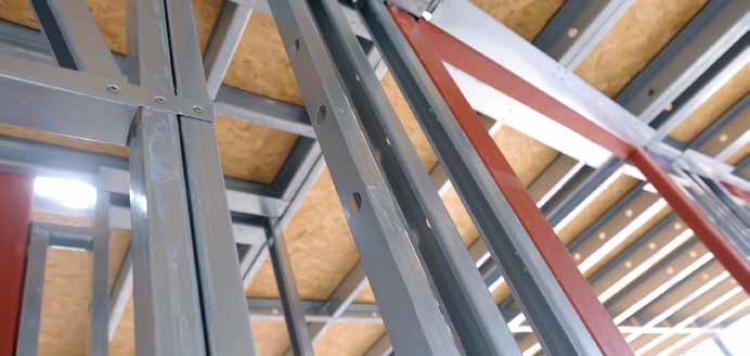Performance in Construction and In Use
DAMAGE TO A STRUCTURE DURING CONSTRUCTION THROUGH MOISTURE OR FIRE LEADS TO CONTRACTUAL DELAYS, EXPENSIVE REMEDIATION WORKS OR EVEN COMPLETE LOSS OF STRUCTURE. A KEY ADVANTAGE OF LIGHT STEEL FRAME WHEN COMPARED TO TIMBER STRUCTURES IS FIRE PERFORMANCE AND PROTECTION FROM WEATHER DURING THE CONSTRUCTION PROCESS.
Construction companies and property developers may find it difficult to arrange insurance cover on potentially high-risk projects unless they can demonstrate good fire safety standards. On larger projects, insurers will normally require compliance with at least the standards set out in the fire prevention on construction sites Joint Code of Practice.
Health and Safety Executive (HSE) Document HSG 168 - Fire Safety in Construction, provides excellent advice on the steps to be taken to reduce the risk from fire. The document highlights
the three elements required to start a fire – a source of ignition, fuel and oxygen and notes that removing one of the three negates that risk.
Light steel frame structures do not add to the fire load of the building. Constructing in light steel frame has limited combustible materials and therefore reducing the fuel for the fire and limiting risk of damage. This risk is reduced further when concrete or screed on steel deck is used rather than a timber deck.
The following should be noted with regards to the performance of a light steel frame structure during construction:
Moisture
Unaffected by short term exposure to moisture and no shrinkage, greatly reducing costly and unsightly re-work.
Dimensional Stability
Movement with steel is minimal compared to other materials and therefore predictable.
Accuracy
Manufactured and installed to higher tolerance than traditional methods of construction, meaning other components are likely to fit first time and without the need for adjustment.
Non-Combustible
No risk of steel contributing to fire load during, or after construction.
LIGHT STEEL FRAME STRUCTURES FULLY COMPLY WITH THE REQUIREMENTS OF THE BUILDING REGULATIONS AND LEADING WARRANTY PROVIDERS. PERFORMANCE COVERS STRUCTURAL, FIRE, ACOUSTICS, THERMAL, AIRTIGHTNESS, WEATHER-TIGHTNESS, SHRINKAGE, PROGRAMME AND ACCURACY.
Performance of light steel is assessed through rigorous testing and it should be noted that a tested ‘systems approach’ is preferred rather than a tested product. When meeting the Building Regulations steel frame is more than ABLE:
A Structure - LSF structures, with their well understood section properties are capable of being optimally engineered to ensure highly efficient material use with a reduction in materials of up to 50%. In addition to high strength to weight ratio, LSF systems with widely distributed points of connection, are also ideally suited to design to avoid the risk of disproportionate collapse.
B - Fire - LSF frames are non-combustible and will not contribute to spread of fire during construction. Fire performance of LSF systems is based on extensive testing. LSF walls and cassette floors are protected using plasterboard for up to two hours. Composite metal deck/concrete floors have an inherent fire rating, with ratings of upwards of two hours achievable.
L - Thermal - as steel is an extremely good conductor of heat, thermal bridging is a key consideration with LSF wall systems. All LSF systems use warm frame principles, whereby insulation is placed outside the frame, keeping the frame warm and eliminating the risk of interstitial condensation. Similar principles are applied at junctions to reduce linear thermal losses and maintain durability.
E - Acoustics - LSF systems rely on isolating the structure of the building from the finishes, thus reducing the amount of acoustic energy transferred between different areas of the structure. Robust and reliable acoustic performance is achieved, using well established and tested principles, further aided by the dimensional accuracy inherent in LSF structures.
For further Information on performance in construction go to: www.lsf-association.co.uk/library/lsfa-specification-and-engineering-guide
Read the latest issue of LSF Magazine here
